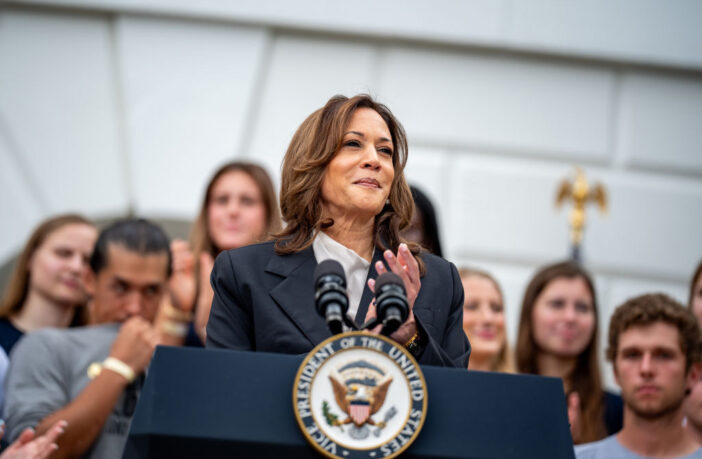By Jovane Marie
History was made and made again during the 2020 election. From the most votes cast in a presidential election in U.S. history to a wave of new, young, novice, minority and LGBTQIA+ representatives in Congress, the litany of firsts made an immediate impact, widening representation among our elected leaders and laying out a new landscape of inclusion and diversity.
It was the election of Kamala Devi Harris, however, to the second-highest office in the country –making her the highest-ranking woman in the history of American politics – that tipped the scale and underscored its historic relevance.
Harris’ current title, Madam Vice President, is just the latest in an enduring, ceiling-shattering career of firsts.
This trailblazer is no stranger to making history and could make it again with the upcoming election in November.
Paving the Way
Long before her ascension to the vice-presidency, Harris’ resume of firsts had ensured her place in the history books several times over.
First African-American, first South Asian-American, and first woman elected district attorney of San Francisco. First African-American, first South Asian-American, and first woman attorney general of California. First Indian-American woman and second Black woman elected to the U.S. Senate.
Focused, determined, and passionate, her accomplishments can be traced back in part to her upbringing, her education, and a piece of life-shaping advice offered by her mother: “Don’t sit around and complain about things, Kamala. Do something.”
Armed with Education
Harris’ monumental career is rooted in an educational foundation that provided a unique perspective and experience to her journey. As the daughter of academically inclined parents – both earned doctorates in their respective fields – the expectation was to excel.
She earned a degree in political science and economics from the illustrious Howard University (chosen largely due to the fact that her hero, trailblazing lawyer and Supreme Court Justice Thurgood Marshall, also attended). Immersed in and influenced by the unmatched cultural atmosphere offered by a historically Black college, she credits the experience as formative to her personal evolution.
“I became an adult there,” the former senator shared in a Washington Post interview. “Howard very directly influenced and reinforced – equally important – my sense of being and meaning and reasons for being.”
Surrounded by a common-place sense of political awareness and activism, Harris’ credence in the value of racial representation in government and corporate institutions was stoked during her tenure, alongside a keen sense of argumentation and an overarching belief that the best way to change a system is from the inside out. Internships with Senator Alan Cranston of California and the Federal Trade Commission, as well as jobs at the National Archives and the U.S. Bureau of Engraving and Printing, provided a pathway to do so.
By the time she graduated in 1986, she had made her mark: chairing the economics society, leading the debate team, participating in campus activism, and joining Alpha Kappa Alpha Sorority, Inc. (the first African-American Greek-lettered sorority).
Her postgraduate journey led her to the University of California Hastings College of Law, where she attended as part of the Legal Education Opportunity Program and served as president of the Black Law Students Association before graduating in 1989 and being admitted to the California Bar the next year.
If Harris’ varied collegiate experience was the catalyst for her career of service, then her family was the incubator. Years before she ever pursued higher education, she was surrounded and influenced by a familial tradition of public service.
“Growing up, there was no question in my family that you must serve,” she said during a lecture at Spelman University in 2018. “There was simply no question.”
Her maternal grandfather, P.V. Gopalan, was a high-ranking government official who fought for Indian independence; her grandmother, Rajam, was an activist who traveled the countryside teaching impoverished women about birth control.
In fact, her decision to enter the legal field was influenced heavily by her grandfather, who she frequently overheard discussing politics, corruption, and justice while visiting India during her childhood.
“The lessons I learned from my grandfather are a big reason I do what I do today,” she said during an event supporting India’s Independence Day. “Lawyers have a profound ability to be a voice for the vulnerable and the voiceless, and that’s what I wanted to be.”
Raised to Make a Difference
To understand the trajectory of Harris’ life and her journey to the White House, you have to understand where she comes from. The daughter of two immigrants, her upbringing centered and solidified her identity and desire to be engaged and aware of the politics, organizations, and struggles of the Black community – and beyond.
Her father, Donald Harris, an emeritus professor of economics at Stanford, was born in Jamaica’s St. Ann’s Parish and came to the University of California at Berkeley in the early 60s on a scholarship from the British colonial government. Drawn to the civil rights movement, he joined the school’s Afro American Association, a building block of the Black Power movement that would help build the discipline of Black studies, introduce the holiday of Kwanzaa, and establish the Black Panther Party. An astute academic, he viewed the US as a “lively and evolving dynamic of a racially and ethnically complex society,” and was the first Black scholar to receive tenure in Stanford’s economics department.
It was her mother, Shyamala Gopalan, a renowned breast cancer research scientist, however, whom Harris credits with being most responsible for shaping her into the woman she has become.
“I’m the daughter of a mother who broke down all kinds of barriers,” she shared last Mother’s Day. “Shyamala was no more than five feet tall, but if you ever met her, you’d think she was seven feet. She had such spirit and tenacity, and I’m thankful every day to have been raised by her.”
The oldest child in a high-achieving Brahmin family from Tamil Nadu, India, Gopalan relocated to the states in 1960 to pursue a doctorate in endocrinology at UC Berkeley, receiving her PhD the same year Harris was born. She, too, was drawn to the energy of the civil rights movement, and as a former colonial subject and person of color, found herself wholly accepted into the Afro American Association.
It was against this backdrop of activism and change that she and Donald met, married, and began expanding their family (with Kamala in 1964, followed by sister Maya in 1967).
Harris fondly recalls her early grounding in the movement for equality: the energetic waves of bodies and voices as she attended protests with her parents; hearing Shirley Chisholm, the first Black woman to mount a national campaign for president, speak in 1971; and being part of the second class to integrate her elementary school.
“My parents would bring me to protests strapped in my stroller, and my mother raised my sister and me to believe that it was up to us and every generation of Americans to keep on marching,” she divulged during her first campaign appearance as the Democratic vice-presidential nominee.
“It’s because of them and the folks who also took to the streets to fight for justice that I am where I am. They laid the path for me.”
When the couple divorced in 1971 (Harris was seven), Gopalan settled in Oakland, California, and took on the sole role of raising her daughters, simultaneously balancing a growing research career, protesting and advocating for civil rights, and bringing up her biracial children with an understanding and appreciation of both of their cultural identities – especially their Blackness.
“My mother understood very well that she was raising two Black daughters,” Harris wrote in her 2019 autobiography, The Truths We Hold. “She knew that her adopted homeland would see Maya and me as Black girls, and she was determined to make sure we would grow into confident, proud Black women.”
To that end, Gopalan herself adopted African-American culture, ensuring her daughters attended a Black Baptist church with neighbors and a preschool with prominent photos of Frederick Douglass and Harriet Tubman, as well as surrounding them with the supplemental love, guidance, and support of her fellow Afro American Association members.
The culmination of this conscious and nurturing upbringing resulted in Harris’ fully realized and unapologetic acceptance of her multicultural identity. In her words, both her Black and Indian heritages are of equal weight in terms of who she is.
“The point is: I am who I am. I’m good with it,” she told the Washington Post while on the campaign trail. “You might need to figure it out, but I’m fine with it.”
For the People
The impact of Harris’ appointment to the second-highest office in the nation is – much like the former senator herself – multifaceted. Americans who have never seen themselves represented in the country’s absolute highest echelons now have the chance.
It is a responsibility she does not take lightly. Time and again, Harris has proven through her words and actions that she is acutely aware of her ability to engage with and appeal to many American identities, and committed to her duty of ensuring they are seen and heard.
She is a source of pride for the children of immigrants and the Black, Indian, and South Asian communities, expanding the beliefs and perceived potential of how high they can ascend and how much they can influence the American story.
She embodies the fighting spirit of women and girls of all races, backgrounds, creeds and political affiliations, encouraging them to speak up as they make their ways through life.
“What I want women and girls to know is this: You are powerful and your voice matters,” she told Marie Claire. “You’re going to walk into many rooms in your life and career where you may be the only one who looks like you or has had the experiences you’ve had. But you remember that when you are in those rooms, you are not alone.
We are all in that room with you, applauding you on. Cheering your voice. So you use that voice and be strong.”
She personifies the grit and legacy of Black women like Shirley Chisholm and Carol Moseley, and is reflected in the millions of little girls of color who see their faces in her, challenging them to stand firm in their identities and what they bring to the table.
“There will be people who say to you, ‘You are out of your lane,’” she told participants of the 2020 Black Girls Lead conference. “They are burdened by only having the capacity to see what has always been instead of what can be. But don’t you let that burden you.
Don’t be burdened by their perspectives or judgement, and do not let anyone ever tell you who you are. You tell them who you are.”
She, along with her husband, Doug, and step-children Cole and Ella (who lovingly call her Momala), are a shining example of the beauty of family – no matter how they are constructed. All you need, she posits, is love.
“The thing about blended families is this – if everyone approaches it in the way that there’s plenty of love to share, then it works,” she said about her modern-day brood. “And we have plenty of love to share within our extended family.”
And, perhaps most importantly, she is an enduring reminder that while breaking barriers may be painful, the fight is worth it to ensure that the next generation will have a path. It is the immortal lesson given to her by the most important role model of her life: her mother.
“My mother would look at me and she’d say, ‘Kamala, you may be the first to do many things, but make sure you’re not the last,’” she recalls often. “That’s why breaking those barriers are worth it. As much as anything else, it is also to create that path for those who will come after us.”
Guided by this life motto, Vice President Harris knows one thing for sure – she may be the first woman to hold the office, but she won’t be the last.
Explore more articles for the Women Community here.



